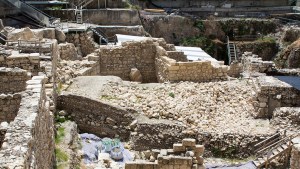The ancient Syrian city of Palmyra was one of the world’s greatest losses of 2015. The protected UNESCO World Heritage site was severely damaged when the region fell under ISIS occupation. Now there is hope that the historical ruin may be restored thanks to the use of digital technology.
The Art Newspaper reports that before the ancient city was destroyed, a 3D-printed model of the site was created as a guide for the restoration. The model, set to a scale of 1:300, was constructed using a staggering 55,000 aerial photographs. This model has been placed on display at the Hermitage Museum in St. Petersburg, Russia, for the exhibition “Two Palmyras: Real and Virtual.”
The Hermitage Museum interviewed Mikhail Piotrovsky, General Director of the State Hermitage, who said of the model:
With the aid of the 3D model, each little stone can be virtually lifted, moved and put in place, and we can discuss what can actually be put back in its place and what cannot. Because under present-day rules of restoration, what has been destroyed is not recreated. UNESCO’s latest decision is that no work should be carried out until the international community reaches some sort of conclusion.
The display at the Hermitage Museum includes the 3D model of Palmyra, alongside digital models of the Temple of Bel. The Temple is shown in two iterations, both before and after its destruction by ISIS. The architects have also created a scale model of one of the column’s capital blocks for reference.
An interactive digital model
The digital 3D models, which are available for interactive viewing on the project’s website, cover about 20km of space. The website notes that the model took more than 700 million polygons to complete. The aerial photographs were used in tandem with ground photos to capture the fine details.
With high hopes of faithfully restoring the site, the international teams are set to continue their efforts. Natalya Solovyova, Deputy Director of St Petersburg’s Institute of the History of Material Culture, told Art Newspaper that the next step will be to combine all research and footage of the city with the 3D model. The end result will be a geo-information system called “Palmyra in Time and Space,” which will guide the restoration.
Learn more about the project and interact with the highly detailed digital map here.

Read more:
The ruin of Solomon’s Temple aids in study of Earth’s magnetism
